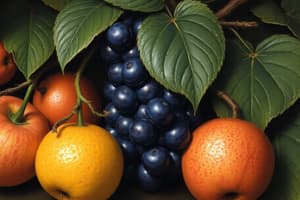Podcast
Questions and Answers
Match the fruit family with the fruits it includes:
Match the fruit family with the fruits it includes:
Rosaceae = Peaches, plums, cherries, mangoes Solanaceae = Tomatoes, eggplants
Match the color category with the fruits it includes:
Match the color category with the fruits it includes:
Red Fruits = Apples, strawberries, cherries Yellow Fruits = Bananas, lemons, mangoes
Match the fruit shape category with the fruits it includes:
Match the fruit shape category with the fruits it includes:
Spherical Fruits = Oranges, strawberries, tomatoes Oval Fruits = Apples, pears, avocados Elongated Fruits = Bananas, cucumbers, eggplants
Match the dispersal mechanism category with the fruits it includes:
Match the dispersal mechanism category with the fruits it includes:
Match the following fruit types with their characteristics:
Match the following fruit types with their characteristics:
Match the following fruits with their classification by development:
Match the following fruits with their classification by development:
Match the following fruits with their characteristics:
Match the following fruits with their characteristics:
Match the following fruit types with their examples:
Match the following fruit types with their examples:
Match the following fruit-bearing plant families with their associated fruits:
Match the following fruit-bearing plant families with their associated fruits:
Match the following fruits with their seed characteristics:
Match the following fruits with their seed characteristics:
Flashcards are hidden until you start studying
Study Notes
Types of Fruits
Fruits are a diverse group of plant-derived foods that are enjoyed by people worldwide. They provide essential nutrients such as vitamins, minerals, and dietary fiber. Fruits come in a variety of shapes, sizes, colors, and flavors, which can be exploited by plants to attract specific pollinators and seed dispersers. The classification of fruits is based on their function, development, and the plant that bears them.
Classification by Fruit Development
Fruits can be classified into three main categories based on their development:
-
Pepo Fruits: These fruits are formed from the entire ovary wall and contain a single seed. Examples include watermelon, cantaloupe, and cucumber.
-
Drupe Fruits: These fruits are formed from the ovary wall and part of the ovary wall that surrounds the seed. The seed is enclosed in a hard endocarp. Examples include peaches, plums, cherries, and mangoes.
-
Berry Fruits: These fruits are formed from the ovary wall and the receptacle, which is the part of the flower that supports the ovary. The seed is enclosed in the fruit's fleshy pericarp. Examples include grapes, strawberries, and tomatoes.
Classification by Plant Family
Fruits can also be classified based on the plant family that bears them. Some common fruit-bearing plant families include:
- Cucurbitaceae: This family includes pepo fruits like watermelon, cantaloupe, and cucumber.
- Rosaceae: This family includes drupe fruits like peaches, plums, cherries, and mangoes.
- Solanaceae: This family includes berry fruits like tomatoes and eggplants.
Classification by Color and Shape
Fruits can also be classified based on their color and shape:
- Color: Fruits can be classified into two categories based on their color:
- Red Fruits: Examples include apples, strawberries, and cherries.
- Yellow Fruits: Examples include bananas, lemons, and mangoes.
- Shape: Fruits can be classified into three categories based on their shape:
- Spherical Fruits: Examples include oranges, strawberries, and tomatoes.
- Oval Fruits: Examples include apples, pears, and avocados.
- Elongated Fruits: Examples include bananas, cucumbers, and eggplants.
Classification by Dispersal Mechanism
Plants have evolved various strategies to attract seed dispersers. Fruits can be classified based on the type of dispersal mechanism they use:
- Mammal-Dispersed Fruits: These fruits are large, smelly, and have a protective husk. Examples include figs, dates, and coconuts.
- Bird-Dispersed Fruits: These fruits are small, have bright colors, and are often wind-dispersed. Examples include berries, cherries, and grapes.
Studying That Suits You
Use AI to generate personalized quizzes and flashcards to suit your learning preferences.




